There’s really only one reason people go to Siem Reap, and that’s to see Angkor. Angkor Wat specifically, and the entire complex of Angkor temples in general.
“Angkor” literally means “Capital City” or “Holy City”, and “Khmer” refers to the dominant ethnic group in modern and ancient Cambodia. In modern usage, Angkor has come to refer to the capital city of the Khmer Empire that existed between the 9th and 12th centuries A.D., as well as to the empire itself. The temple ruins in the area of Siem Reap are the remnants of the Angkorian capitals, and represent the pinnacle of the ancient Khmer architecture, art and civilization.”
- Seam Reap Angkor Visitor’s Guide
Angkor Wat is the largest and best known of the structures in Angkor Archeological Park, though it is by no means the only one. In fact, the area is littered with more than a thousand temple remains and other structures, large and small. Some have been reclaimed from the jungle and restored, while others are little more that unidentifiable heaps of stone overgrown with trees.
 A tumbledown corner of Ta Som, one of the smaller and less loved temples, but a favourite of mine.
A tumbledown corner of Ta Som, one of the smaller and less loved temples, but a favourite of mine.
The area covered by Angkor Archeological Park is massive, and if you add the ruins that fall outside the site the whole area covered by Angkor monuments is purported to be about 1,000 square kilometers of ancient urban sprawl. This means it’s not the kind of place you can explore on foot. People use lots of methods to get around the site – car, motorcycle, and bicycle – but the most common method is to take a tuk tuk. This is a term you hear a lot in Asia, and they take different forms in different places. In Cambodia a tuk tuk is a two-person trailer attached to the back of a motorcycle.
When I first arrived in Siem Reap I was really unsure about how to make the most of my time at Angkor. I’d planned three full days, but really didn’t know where to start. Should I book myself on a guided tour? Go it alone? Get a private guide? It was a bit bewildering. I wanted to make sure I saw what I came to see and that I understood what I was seeing at the same time. In the end I booked a tuk tuk and a private guide for my first day, and went guide-less on the second and third days. A tuk tuk for each day was $10, and the services of an English-speaking guide were $25. Those are U.S. dollars I’m talking about. Strangely, though Cambodia has its own currency – the real – U.S. dollars are used more frequently than real. Bank machines give out USD, and most prices are quoted only in USD. And though the actual exchange rate is about 4,100 real to the dollar, the locals simply use 4,000:1, and mix currencies as needed to make change. Anything less than a dollar is always given in real, so if you buy something for $3.50 and tender a five dollar bill you’ll get one American dollar back and 2,000 real. It’s odd, but it works.
But back to Angkor. I spent about 12-14 hours exploring Angkor over three days, which is not really much time. Many people start at sunrise and stay until sunset day after day, but they are obviously hardier than me (or perhaps haven’t been traveling for over three hundred days and hence are slightly keener). I decided, after my first long day of guided tourdom, that I really couldn’t appreciate more than about three or four hours of temple trekking on a single day. More than that and the heat turned me into a sweaty, cranky grump who wanted nothing more than a cold shower and a colder drink.
As seems to be my habit here in Southeast Asia, I unknowingly arrived in Siem Riep just in time for a huge festival. This one was a gathering of Buddhists from all over Asia – an event that happens only once every ten years. As many as 4,000 monks, and lots more lay people would descend on the Angkor sites while I was there. This was brought home to me by the traffic jam encountered on the way into the park. Luckily the jam cleared as we got a bit further away from Angkor Wat, and on to the first temple.
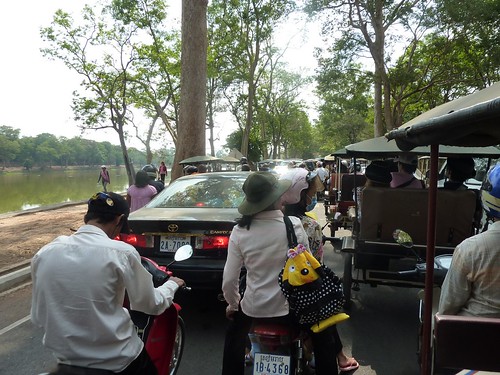 Tuk tuks everywhere! To the left is part of the square moat that surrounds Angkor Wat – more than one kilometer long on each side.
Tuk tuks everywhere! To the left is part of the square moat that surrounds Angkor Wat – more than one kilometer long on each side.
Ta Prohm (literally “Grandfather Mountain”) is a favourite for visitors and is sometimes called the Tomb Raider Temple, because it’s got some of the best tree-in-temple photo ops in the park. The trees – spung trees - actually grown on top of a lot of the temples with their roots stretching down into the rocks beneath; the suspicion is that the seeds are dropped by birds that land and deposit them. The larger ones are three or four hundred years old and though they’re picturesque, they are destroying the temples that support them. In some cases they’ve been left in place, but many others are eliminated, though this is difficult because they’re incredibly hardy and have to be completely removed, roots and all, to ensure they won’t grow back.
Ta Prohm is a Buddhist temple, but Angkor also boasts many Hindu temples as well. The Angkorian kings switched back and forth between Buddhism and Hinduism frequently, and built according to the prevailing religion of the time. When Hinduism was in ascendency, new temples were built in that style, and the images of Buddha in existing Buddhist temples were chipped away and discarded while Hindu imagery was installed. When Buddhism was back in vogue, the Hindu temples were cleansed and stocked with Buddhas, so even if a temple was built as one or the other, you can generally see imagery from both faiths in each.
I preferred the Buddhist temples for one simple reason – they are at ground level. The Hindus temples all involve climbing incredibly steep staircases up to a central tower. And in the stifling heat and humidity that pervaded my every moment at Angkor, those staircases were like the twist of the knife.
 The steps up to Ta Keo, and these ones weren’t bad.
The steps up to Ta Keo, and these ones weren’t bad.
I also had a look around the Angkor Thom complex – the walled royal city surrounded by a moat, and the last capital of the Angkorian empire. This was the place that most of the Buddhist celebrants gathered, so there were grandstands set up and loads of people around. And here you could see the difference in attitude between the tourists and the faithful. The tourists were out in the heat, dragging themselves around the various temples and other structures within the city walls. The local people there for the festival had set out blankets in the shade or slung up hammocks, and were laying around napping, chatting, eating, and otherwise not expending much energy at all. Oh, how I envied them.
But of course there were ruins to see and photos to take so despite the fact that I was quickly melting, I soldiered on. I’m not sure whether I’m just particularly sensitive to the heat, but as I looked at the people around me, I couldn’t help but notice that for the most part they looked fresh and dry. Oh perhaps there might have been a discreetly mopped brow here or there, but none of them seemed to be suffering like I was, and many were wearing long pants and long sleeves. And then there was me, hair plastered to my head, sweat dripping off the tip of my nose, and embarrassing damp patches on my pants, feeling like I was back in the Russian banya. Really, I cannot overstate how much I dislike this climate. I’m showering two to four times a day, and sweating through my shirts in minutes. The moderate temperatures of Japan can not come soon enough.
But back to Angkor – the biggest temple inside Angkor Thom is Bayon, a Buddhist structure (yay!) famous for the giant carved faces that adorn each side of the 37 towers still standing within its walls. The faces are said to be that of Jayavarman VII, arguably the greatest of the Angkorian kings, ruling the the late 12th century.
 One of the giant faces of Bayon – I estimate most were six to ten feet high
One of the giant faces of Bayon – I estimate most were six to ten feet high
And of course there was Angkor Wat. And I might as well get this out of the way right now: it was smaller than I was expecting. Considering it’s claimed to be the largest single religious monument in the world I thought I’d be blown away by the scale. Instead, I found the actual temple to be pleasant, but not overwhelming. Certainly the grounds in which the temple stands are huge – the walls enclose an area of 302 acres. During the time Angkor was occupied they would have been filled with wooden houses and other buildings, but now it’s mostly jungle. True, the walls of Angkor Wat have some very impressive bas relief carvings, some of which depict scenes from history and others which tell stories from Hindu mythology (Angkor Wat is a Hindu temple… Boo!). But overall I found some of the other temples in the area more interesting and more fun. So sue me.
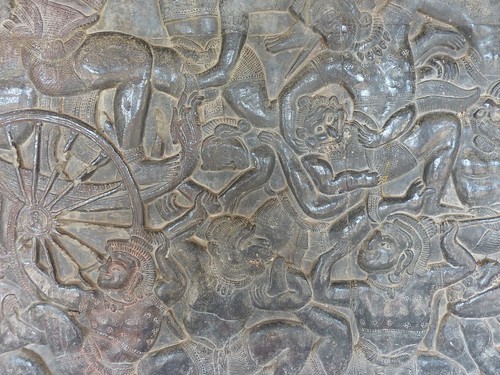 One small section of carving at Angkor Wat, burnished to a shine by the casual touch of thousands of hands over hundreds of years
One small section of carving at Angkor Wat, burnished to a shine by the casual touch of thousands of hands over hundreds of years
I did climb to the top of Angkor Wat, though I waited until my last day to do that. The line to go up to the top was long and unshaded for the most part, and I was pretty underwhelmed when I got there. I’m sorry if this sounds jaded – but it just wasn’t that interesting. Still, I’m glad did it, if only so I can report back that it just wasn’t that interesting.
 Mandatory shot of me in front of Angkor Wat
Mandatory shot of me in front of Angkor Wat
What was interesting were two temples I saw on my second day of exploring. Ta Som is the most far flung of the temples in the main area of the park. When I visited there weren’t many people around so I got to enjoy exploring the temple in relative peace. Ta Som was a small Buddhist monastic complex, and has a great spung tree on the eastern gate, and some nice ruined bits. It was small and quiet, and I liked it very much.
 Part of the walls around Ta Som, and the encroaching jungle
Part of the walls around Ta Som, and the encroaching jungle
However, by far my favourite site at Angkor was Preah Kahn (“Sacred Sword”). This is another Buddhist monastic complex, but much bigger than Ta Som. The guidebook calls it “highly explorable”, and they’re not kidding. Around the time I arrived at Preah Kahn there was a short rain shower. At first it was light enough that I simply ignored it and continued making my way through the complex. When the rain got harder I simply turned off into a little alcove, of which there were many, and sat down on a pile of stones and waited it out. It was quiet and blessedly cooler because of the rain, and only two people passed me the whole time I waited.
Once the rain stopped I continued my exploring, and it was great. There were lots of corridors and rooms, and some open courtyards, and spots where areas were blocked by rubble. You could wander just about anywhere – under archways and through narrow hallways that lead into small rooms and then into more hallways, across courtyards strewn with big cut stones, around the outer walls, into little crossings where an empty plinth once held a Buddha, and where, to this day, people still burn incense and say prayers.
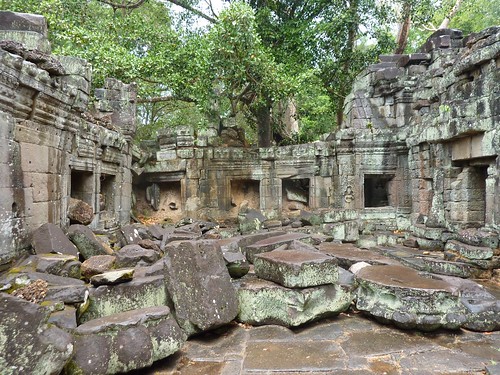 One of the open courtyards at Preah Kahn
One of the open courtyards at Preah Kahn
On my last day at Angkor I tried to see the sun set over Angkor Wat, along with every other tourist in the vicinity. I climbed to the top of Phnom Bakheng (Hindu), which is supposed to be the favoured spot for seeing Angkor Wat by sunset. Well that’s just crap. Viewed from Phnom Bakheng, Angkor Wat is about the size of your thumbnail, and mostly obscured by trees. There was a somewhat picturesque sunset over Tonle Sap lake in the other direction, but I thought the most interesting thing to look at were the crowds of other people there with their tripods and light meters and cameras with lenses longer than their forearms. The people watching was definitely better than the sunset watching.
 The sunset crowd at Phnom Bakheng.
The sunset crowd at Phnom Bakheng.
Overall, I’m not sure that I had the optimum Angkor experience. I didn’t flog myself out of bed to see the sun rise over Angkor Wat, and I wasn’t swept away by the majesty and grandeur of the thing. I found the heat sapped my energy and my enthusiasm a lot of the time, and I got very tired of the touts outside every temple plying me with cold drinks, books, food, bracelets and other gew gaws.
On the other hand, I did get to see some amazing ancient ruins. The temples, walls and monasteries of Angkor really are incredible. Some of them have survived for more than a millennium (despite the fact that no mortar was used between the stones) and represent the remains of an incredible empire. The city of Angkor Thom is estimated to have been home to more than a million people at a time when London could muster only about 30,000. The huge, beatific faces of Bayon, the corridors and back rooms of Preah Khean, and the fantastic spung trees at Ta Prohm and Ta Som were certainly worth the effort. I’m sure I didn’t do it all properly and with due reverence, I just did it my way, like I always do, and that will have to be good enough.

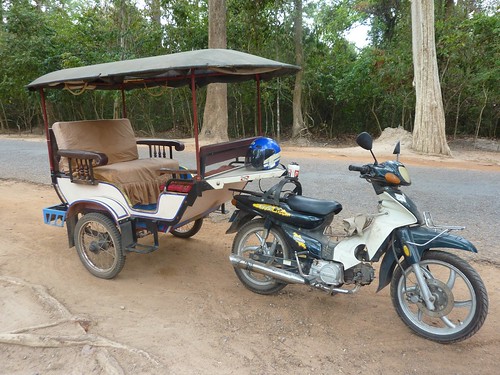
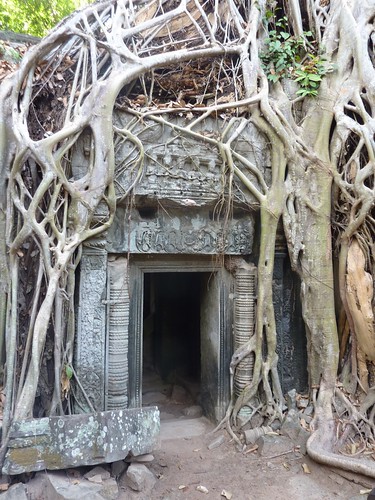



1 Comment:
Radical Suggestion: Try being a tourist without a day-pack. I ditched my traveller habit of a knapsack 6 years ago and have been a happier and much less sweatty tourist ever since. Try it in Japan.
Happy Trails...
rh
Post a Comment